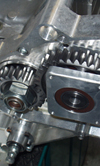The Pull Clutch
 The appearance of the pull type clutch in the race car world in the last decade was driven mainly by considerations of efficiency, consistency, and component life. These factors are improved by an increase in the mechanical advantage of the release mechanism.
The appearance of the pull type clutch in the race car world in the last decade was driven mainly by considerations of efficiency, consistency, and component life. These factors are improved by an increase in the mechanical advantage of the release mechanism.
Starting with the basic operation of a conventional ‘push’ clutch, the ‘push’ that is delivered by a slave cylinder refers to the force that is required to disengage the clutch plates. Upon depressing the clutch pedal, hydraulic fluid is forced into the cylinder which is then thrust out towards the engine to accommodate the extra fluid, taking the release bearing, or bobbin, which is mounted directly onto its nose, with it. This is already in contact with the inner tips of the clutch fingers, but exerts no force on them when the clutch is engaged. We saw last month that the fingers act as radial leaf springs, and that they are preloaded on assembly to obtain the clamp force. They pivot radially on pillars mounted to the cover roughly half way between the input shaft axis and clutch cover outer edge, their outer tips in contact with the plates and applying the clamp load axially. The thrust from the release bearing now applies a bending force to the finger, which is sufficient to overcome the preload within them and therefore the clamping load and so the clutch is disengaged. Notice that the internal forces react in such a way as to push the bellhousing, to which the slave cylinder is rigidly mounted, off the rear face of the engine block when disengaging the clutch.
The pull clutch operates in the reverse manner. The slave cylinder and bobbin are in contact with the inner tips of the clutch fingers, as before, but the assembly is now mounted to a spider that is itself mounted onto the back of the engine block via pillars which just clear the perimeter of the ring gear. When the pedal is pushed in, fluid enters through the spider into an internal chamber arranged so that the slave cylinder now moves away from the clutch, i.e. in the opposite direction, pulling the fingers with it by means of a ring turned into the end of the cylinder body. The fingers are now pivoted on the cover just inboard of its periphery, i.e. outboard of the set of bolts or studs that bolt the clutch assembly to the flywheel. This achieves two things. Firstly, with the pivot outboard of the point of contact between the finger and plate, it compensates for the cylinder moving in the ‘wrong direction’, and ensures that when it does, the force applied still acts in the correct direction to release the preload in the fingers and hence the clamp load in the plates. Secondly, and fundamental to the design, the mechanical advantage obtained by the finger is significantly increased as the effective length of the lever arm now spans the radial cross section of the cover plate. Note also that whereas the conventional ‘push’ design tried to separate the transaxle from the engine when declutching, the pull type accounts for the reaction forces within the assembly of spider to engine block.
Together these factors can then be used to improve feel, or reduce pedal load, or increase clutch capacity without increasing pedal load, or travel. The fulcrum design is simplified, and wear reduced so that the clutch will remain more consistent for longer. The design is also lighter.
As far as installing a pull clutch into an engine installation designed for a push clutch, it may not be so simple. Some modern race engines have the mounting for the release bearing spider integrated onto the rear face of the block, others do not. An adapter plate is then required to provide them. The original slave cylinder mounting, which will have been machined into the front face of the bellhousing or transaxle will then be redundant, but room will be required to accommodate the spider itself, which is unlikely to have been accounted for in the original design as it would have been wasted space. Finally, in addition to the clutch unit itself, the slave cylinder and bearing will be bespoke to the clutch assembly, and new routes will have to be found for the clutch feed and bleed lines.
Written by Peter Elleray.